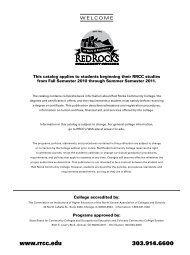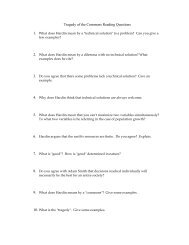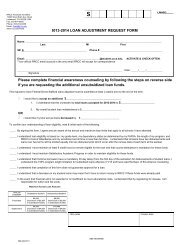opportunities, options, excellence - Red Rocks Community College
opportunities, options, excellence - Red Rocks Community College
opportunities, options, excellence - Red Rocks Community College
You also want an ePaper? Increase the reach of your titles
YUMPU automatically turns print PDFs into web optimized ePapers that Google loves.
ARC121 and 122 Carpenter II<br />
4 Credits Each<br />
This course explores sketching and visualization,<br />
field engineering principles and supervision.<br />
In addition, reinforcing concrete, patented<br />
forms/heavy formwork, wall systems, tilt<br />
up, structural steel, shoring and formwork are<br />
discussed.<br />
ARC 131 and 132 Carpenter III<br />
4 Credits Each<br />
This course presents floor, wall and roof systems,<br />
as well as stair construction, interior finish,<br />
exterior finish and roofing application.<br />
ARC 141 and 142 Carpenter IV<br />
4 Credits Each<br />
This course presents advanced supervision,<br />
and laser instruments, and introduces the<br />
Uniform Building Code. In addition, this<br />
course covers water-and damp-proofing, finish<br />
stairs, supplement to ceiling systems,<br />
metal studs and drywall, interior finish, wall<br />
and floor specialties, and cabinetry.<br />
ARD - APPRENTICE-<br />
RELATED DRYWALL<br />
ARD 111 and 112 Drywall<br />
Applicator (Year One)<br />
4 Credits Each<br />
This course introduces the trade, tools and<br />
materials of the trade, drywall systems, and<br />
blueprints. Topics include safety, human relations,<br />
trade math, material handling and storage,<br />
framing materials and fasteners, basic<br />
non-load-bearing wall framing, ceiling framing,<br />
furring, hanging materials and fasteners,<br />
and wallboard hanging on wood.<br />
ARD 121 and 122 Drywall<br />
Applicator (Year Two)<br />
4 Credits Each<br />
This course presents thermal insulation and<br />
sound control, trim installation, safety,<br />
advanced trade math and layout. The course<br />
also includes load-bearing framing, installing<br />
hollow metal, demountable partitions, special<br />
framing conditions and pre-finished gypsum<br />
board, wallboard hanging on metal walls and<br />
ceilings, laminated applications, angles and<br />
curves, laser instruments, interior finish (ceiling<br />
systems), supplement to ceiling systems,<br />
and finishing procedures.<br />
ARE - APPRENTICE-<br />
RELATED<br />
ELECTRICITY<br />
ARE 111 and 112 Electrical I<br />
4 Credits Each<br />
This course presents general safety, tools of<br />
the electrical trade, contractor-owned tools,<br />
and trade history it introduces electrical theory,<br />
conduit outlet boxes and the National<br />
Electrical Code. This course also explores the<br />
sources of electricity, trade math, laws of electricity,<br />
series circuits, parallel circuits and<br />
series parallel circuits. Other topics include<br />
organization of the National Electrical Code,<br />
magnetism laws, wire devices, service boxes,<br />
connectors, conduit bending, conductors and<br />
insulators, insulation, and pulling large and<br />
small wires.<br />
ARE 121 and 122 Electrical II<br />
4 Credits Each<br />
This course covers blueprint symbols, blueprint<br />
reading, schedules and specifications,<br />
instruments and meters, characteristics of<br />
induction, and AC capacitance. Other topics<br />
include series circuits (AC), parallel circuits<br />
(AC), overcurrent protection, fuses, circuit<br />
breakers, ducting, installing cable tray, wireways<br />
and surface metal raceways, main service<br />
equipment subpanels, grounding conductors,<br />
metallic sheathed cable, and special<br />
wires and cords. In addition, this course introduces<br />
alternating current, Ohm’s Law for<br />
Alternating Current, the theory of grounding<br />
and the general requirements of wiring.<br />
ARE 131 and 132 Electrical III<br />
4 Credits Each<br />
This course presents hazardous locations,<br />
electrical safety, reading diagrams, lighting<br />
fundamentals, fluorescent lighting, high intensity<br />
discharge lighting, fundamentals of DC<br />
motors, DC motors and generators, fixed generators<br />
and portable generators. This course<br />
also explores residential calculations, fixed<br />
electric space heating, fundamentals of AC<br />
motors, control of motor starting, single phase<br />
motors and polyphase motors. Also covered<br />
are the general requirements for commercial<br />
wiring and bussways, as well as motor circuit,<br />
code, types of motors, wire sizing, overload<br />
protection, motor connections and overcurrent<br />
protection.<br />
ARE 141 and 142 Electrical IV<br />
4 Credits Each<br />
This course explores tool and material takeoffs,<br />
electrical safety, reading diagrams, journeyperson<br />
responsibilities, low voltage lighting<br />
control, emergency lighting, special systems,<br />
transformer connections, solid-state fundamentals<br />
and advanced meter applications.<br />
This course also covers high voltage fundamentals,<br />
special occupancies and equipment,<br />
resistive heating cables and special terminations.<br />
ARL - APPRENTICE-<br />
RELATED LABORER<br />
ARL 104 Basic Measuring and<br />
Layout<br />
0.5 Credit<br />
This course teaches students to read and use a<br />
tape measure and apply fractions. Students<br />
are introduced to an automatic level and its<br />
functions and study the most common layout<br />
mistakes. Students are also introduced to the<br />
uses and care of the “chain.”<br />
ARL 105 Crane Setup, Rigging<br />
and Signaling<br />
0.5 Credit<br />
This course studies how to recognize when a<br />
crane is properly set up as well as proper rig<br />
ging. Basic rigging techniques, hand signals,<br />
rigging, inspection and site preparation are<br />
covered. In addition, students will receive a<br />
handbook on rigging with a wallet card of<br />
hand signals.<br />
ARL 107 Scaffold Setup and Safety<br />
Certification<br />
0.5 Credit<br />
This course covers basic equipment terminology.<br />
How to erect and dismantle single-tier<br />
and multi-tier scaffold and the proper use of<br />
hoisting equipment during erection is studied.<br />
Fall protection is also discussed and demonstrated.<br />
ARL 112 Basic Blueprint Reading<br />
0.5 Credit<br />
This course introduces the organization of<br />
project plans and specifications. Discussions<br />
are held regarding the basics of site organization<br />
and building orientation, including access<br />
to the project site. Floor plans and details are<br />
covered.<br />
107 2002 - 2003 <strong>Red</strong> <strong>Rocks</strong> <strong>Community</strong> <strong>College</strong> Catalog
















